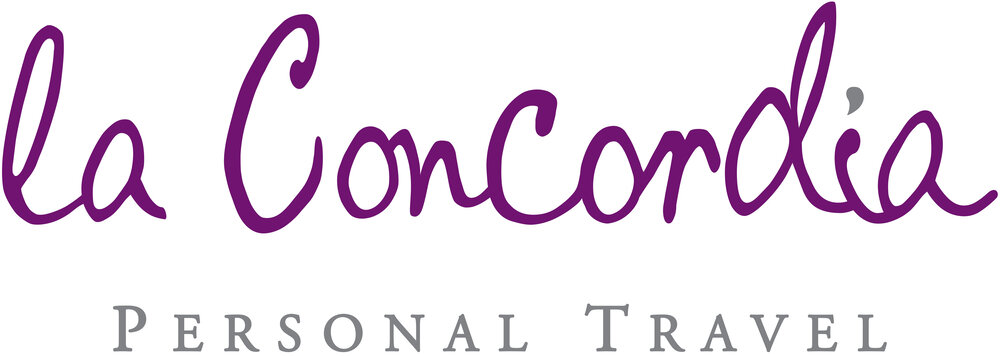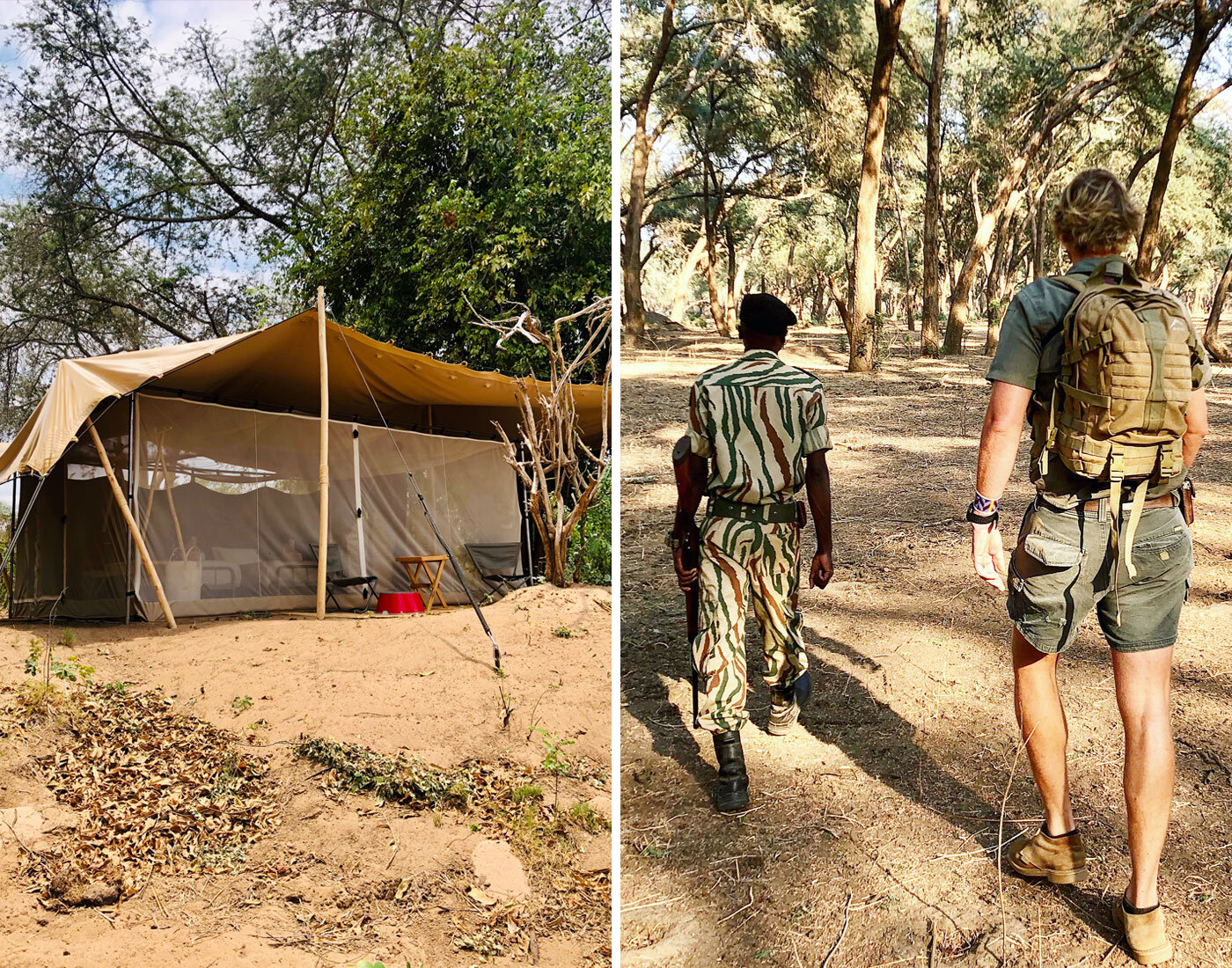Waking slowly, silently, in single file behind an armed ranger in an area covered with wild animals certainly gets your heart pumping. Your senses come alive. You have no idea what will be lurking in the scrubby undergrowth right next to you. You are entirely in the hands of your guide and ranger. But it’s a magical experience getting up close to wildlife without the protection of a vehicle. Honing in on the little things: the territorial markings of a pile of droppings, the paw prints, the alarm calls.
I was in the South Luangwa National Park in Zambia, the home of the walking safari, which was set up by renowned conservationist Norman Carr in the 1960s. With the possibility of walking between bush camps or even overnighting in simple tents under the stars, it’s a fabulous option alongside the traditional vehicle safari to get your wild animal fix.
I split my time in South Luangwa between a stay on the banks of the Luangwa River and in the northern Nsefu Sector, which is drier, harsher and more remote. It’s great to get a different perspective of the park, in terms of landscapes and wildlife, with a stay in two separate locations.
In the north I stayed at Nsolo Lodge, a cute little bush camp made up of five reed and thatch villas set up on raised decks above a dry river bed. It’s rustic luxury with solar power, no Wi-Fi and outside bathrooms, alongside great food, hot showers and huge beds that were insanely comfortable.
Days start early with a 5:15am wake-up call, if the elephants passing through camp hadn’t already woken you up.
Then it’s breakfast under a Sausage Tree, around a camp fire, before heading out on safari.
Back for brunch at around 11ish, you then get the whole afternoon to snooze, watch game from your deck or read a book, before setting out for your evening game drive at 4:00pm. As the sunsets you enjoy sundowners at a beautiful spot before a night drive on the way back to camp. There is something rather thrilling about seeing the bright eyes of animals in the hazy mist of a night light. After freshening up and a few drinks with fellow guests, you all sit down together for dinner under the stars.
During my stay I discovered that South Luangwa is a paradise for game. Great herds of puku, impala, waterbuck and kudu roam everywhere.
Lions are oblivious to humans and vehicles, whilst leopards are unusually prolific.
Crocodile’s lie motionless on the banks of the river.
Pods of hippos crowd together in deep channels in the middle of the river. There are tusked, one tusk and tuskless elephants, a by-product of years of poaching and, between August and November, the migrating beautifully coloured chirruping carmine bee-eaters arrive in droves.
Finishing my time in South Luangwa I went for complete luxury at Chinzombo Lodge, which sits on a sweeping curve of the Luangwa River. This was the site of one of Norman Carr’s original lodges, but it has been reinvented and is something completely unique for South Luangwa. Modernist steel frames sit alongside traditional bush camp features of reed and thatch. Plunge pools look out over the river and fans give way to eco-friendly air conditioning. It’s the perfect spot to watch herds of elephants cross the river each evening as they head to the villages to feed on the mango trees. Then to watch them cross again at breakfast as they head back into the National Park.
Mixing up wildlife viewing with culture, I was eager to visit the studio of Mulberry Mongoose, an excellent initiative that employs local women to create fantastic hand-made jewellery out of snare wire (collected by National Park anti-poaching teams) and local materials from the South Luangwa Valley such as peacock feathers and stone. Much of the proceeds are then used to help the conservation efforts in the area.
Hopping on a small plane I set off to my next stop an hour’s flight away in south-eastern Zambia. The Lower Zambezi Valley, with its majestic escarpment, protects over 4,000 square kilometers of National Park and lies on the northern banks of the Zambezi River.
The lodges are nestled along the river bank in the most beautiful of settings and vary in style. My first stop was the wonderfully rustic Chongwe River Camp, which sits at the confluence of the Zambezi and Chongwe Rivers under a canopy of Winter Thorns. From my deck I could watch the amazing birdlife with my morning coffee or sit quietly as elephants roamed through camp.
Next I moved further downstream to a different part of the National Park where I stayed at the sophisticated Sausage Tree Camp, in one of its eight huge tented suites which each come with a plunge pool. On arrival I was introduced to my Mchinda who looked after me during my stay. But one of the great pluses of a stay at Sausage Tree Camp is that each suite is allocated their own vehicle and guide, so that the activities you do are completely private and done at your own leisure with no strict timetables to follow.
I had the most amazing lunch set up on a sandbank in the middle of the river, where I dined with my feet in the water watching the wonderful birdlife around me.
Whilst at night, dinners were either by torchlight in the bush under a canopy of stars, or by the fire overlooking the river.
But whichever lodge you stay at, one of the top experiences is a canoe safari on the river. Paddling silently means you can get up close to animals on the river banks.
I visited in late October when the land was incredibly dry and so herds of elephants made a daily pilgrimage down to the water’s edge and over to the islands where there was still green grass to eat. Being on the water you can watch them swoop up water with their long trunks and spray it over them or even cross over to the islands, swimming fully submerged save for their trunks.
Other experiences include game drives along the flat floodplains along the river, tiger fishing and evening cruises where you can watch the sunset over the majestic Zambezi River with a G&T in hand!
But if you’re the adventurous sort and do like a bit of “real” camping, then I would highly recommend a stay at Tusk and Mane, which is a new venture by two great guys, Luke and Kyle, who are doing something completely different in terms of safari in Zambia.
A great way to end a Zambian safari is to head to the majestic Victoria Falls. One or two nights are perfect to experience their power and beauty.
With so many safari options available, it’s always difficult to know which one to choose. But for me, Zambia offers a truly authentic safari experience away from the crowds you experience elsewhere. I guess it’s what comes to mind when you think of “real Africa”. No large hotels, minivans or 10 vehicles around a sighting. Instead its small intimate bush camps, with great guiding, excellent game and the ability to actually get out and walk amongst the wildlife. Add on fantastic logistics to get around, it really is a great place to go on safari.
If you would like more information on a safari to Zambia, or elsewhere in Africa, then please do get in touch.
{Photographs: Lesley-Ann}























